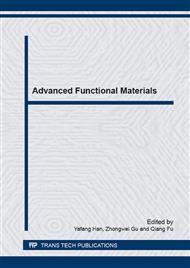p.254
p.263
p.268
p.276
p.281
p.287
p.292
p.297
p.301
Study on the Magnetic Properties and Microstructure of Single-Stage Hot-Deformed Nd-Fe-B Magnets
Abstract:
The Nd-Fe-B powder was prepared to bulk by cold pressing, and then was hot-deformed by the vacuum hot-pressing machine. Effects of hot-deformation temperature and rate on the density, anisotropy, performance and microstructure were studied. The results showed that the grain size was small, but the density and orientation degree was low, thus leading to poor performance when the deformation temperature was too low or deformation rate was too large. When the temperature was higher than 750 °C or the rate was lower than 0.1mm/s, the anisotropic magnets with good density and texture could be obtained. However, the magnetic properties of hot-deformed magnets deteriorated due to the present of coarse grains. From the microstructure of hot-deformed magnets it could be seen that there were plenty of coarse and irregular grains, which have a higher Nd content than the plate-like grains. The optimum magnetic properties could be obtained at deformation temperature of 700 °C and rate of 0.1 mm/s.
Info:
Periodical:
Pages:
281-286
Citation:
Online since:
March 2015
Authors:
Price:
Сopyright:
© 2015 Trans Tech Publications Ltd. All Rights Reserved
Share:
Citation:


